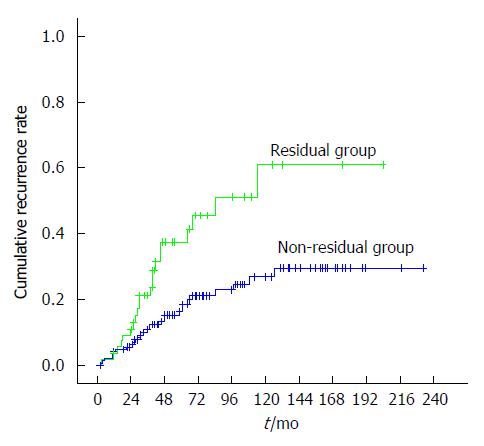Copyright
©The Author(s) 2015.
World J Gastroenterol. Dec 7, 2015; 21(45): 12865-12872
Published online Dec 7, 2015. doi: 10.3748/wjg.v21.i45.12865
Published online Dec 7, 2015. doi: 10.3748/wjg.v21.i45.12865
Figure 1 Connecting the opened neighboring bile ducts to form a “hepatobiliary basin” (A); Obtaining a 12-15 cm free jejunum segment with a vascular pedicle (B); Performing a side-to-end anastomosis between the distal end of the free jejunum segment and the “hepatobiliary basin” (C); and Embedment in the skin after the closure of the free jejunum segment at its proximal end (D).
Figure 2 Oddi sphincter preserved cholangioplasty with hepatico-subcutaneous stoma in which the free jejunum segment served as the subcutaneous stoma (A) or in which the gallbladder served as the subcutaneous stoma (B).
AW: Abdominal wall.
Figure 3 Cumulative stone recurrence curves of the residual group (n = 55) and non-residual group (n = 147) (log-rank test, P = 0.
001).
- Citation: Lian YG, Zhang WT, Xu Z, Ling XF, Wang LX, Hou CS, Wang G, Cui L, Zhou XS. Oddi sphincter preserved cholangioplasty with hepatico-subcutaneous stoma for hepatolithiasis. World J Gastroenterol 2015; 21(45): 12865-12872
- URL: https://www.wjgnet.com/1007-9327/full/v21/i45/12865.htm
- DOI: https://dx.doi.org/10.3748/wjg.v21.i45.12865











